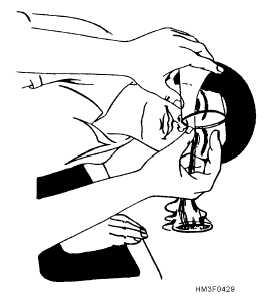DO NOT press against the eye or manipulate it
in any way that might cause the object to become
embedded in the tissues of the eye. Be very
gentle; roughness is almost sure to cause injury
to the eye.
DO NOT use such things as knives, toothpicks,
matchsticks, or wires to remove the object.
DO NOT UNDER ANY CIRCUMSTANCES
ATTEMPT TO REMOVE AN OBJECT
THAT IS EMBEDDED IN THE EYEBALL
OR THAT HAS PENETRATED THE EYE!
If you see a splinter or other object sticking out
from the eyeball, leave it alone! Only specially
trained medical personnel can hope to save the
victim’s sight if an object has actually penetrated
the eyeball.
Small objects that are lodged on the surface of the
eye or on the membrane lining the eyelids can usually
be removed by the following procedures:
1. Try to wash the eye gently with lukewarm,
sterile water. A sterile medicine dropper or a
sterile syringe can be used for this purpose.
Have the victim lie down, with the head turned
slightly to one side as shown in figure 4-29.
Hold the eyelids apart. Direct the flow of water
to the inside corner of the eye, and let it run
down to the outside corner. Do not let the water
fall directly onto the eyeball.
2. Gently pull the lower lid down, and instruct the
victim to look up. If you can see the object, try to
remove it with the corner of a clean
handkerchief or with a small moist cotton swab.
You can make the swab by twisting cotton
around a wooden applicator, not too tightly, and
moistening it with sterile water.
CAUTION: Never use dry cotton anywhere
near the eye. It will stick to the eyeball or to the
inside of the lids, and you will have the problem
of removing it as well as the original object.
3. If you cannot see the object when the lower lid is
pulled down, turn the upper lid back over a
smooth wooden applicator. Tell the victim to
look down.
Place the applicator lengthwise
across the center of the upper lid. Grasp the
lashes of the upper lid gently but firmly. Press
gently with the applicator.
Pull up on the
eyelashes, turning the lid back over the
applicator. If you can see the object, try to
remove it with a moist cotton swab or with the
corner of a clean handkerchief.
4. If the foreign object cannot be removed by any
of the above methods, DO NOT MAKE ANY
FURTHER ATTEMPTS TO REMOVE IT.
Instead, place a small, thick gauze dressing over
both eyes and hold it in place with a loose
bandage. This limits movement of the injured
eye.
5. Get medical help for the victim at the earliest
opportunity.
Head Wounds
Head wounds must be treated with particular care,
since there is always the possibility of brain damage.
The general treatment for head wounds is the same as
that for other fresh wounds. However, certain special
precautions must be observed if you are giving first aid
to a person who has suffered a head wound.
NEVER GIVE ANY MEDICATIONS.
Keep the victim lying flat, with the head at the
level of the body. Do not raise the feet if the face
is flushed.
If the victim is having trouble
breathing, you may raise the head slightly.
If the wound is at the back of the head, turn the
victim on his side.
Watch closely for vomiting and position the head
to avoid aspiration of vomitus or saliva into the
lungs.
4-37
Figure 4-29.—Irrigating the eye.

